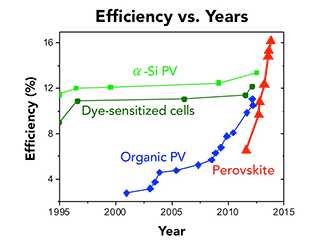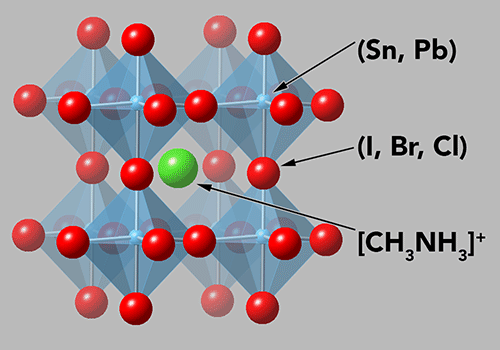Dr. Zhaoyang Fan Awarded $330,000 NSF Grant to Develop Organometal Halide Perovskites

By Amanda Miller
and Dr. Zhaoyang Fan
As society continues the search for cleaner, renewable, and more reliable energy resources, one promising option has emerged: solar cells. Harnessing energy by converting sunlight (or photons) into electrons that yield electric current, these "photovoltaic" cells hold much promise for the future of powering our homes and other appliances. However, in order to make this a reasonable possibility, the cost and efficiency of these cells and the ease of their production must be improved significantly.
Currently, about 85 percent of the photovoltaic market is based on crystalline silicon, the same material used to create tiny electronic chips in computers. However, to harvest a significant amount of solar energy, we need large-area solar cells. Material and production cost is an issue, considering that silicon cells must be thick (hundreds of micrometers) to fully absorb the sunlight. The manufacturing processes of crystalline silicon and their cells are also very expensive, while these cells' efficiency is still far below 20 percent when commercially manufactured. The remaining 15 percent of the cell market is based on the so-called second generation photovoltaic cells that consist of polycrystalline thin films, which are only around 1-10 micrometers thick. These thin-film cells tend to be cheaper with a shorter energy payback time. However, most of them use earth-rare elements such as tellurium, gallium, indium, and cadmium. That becomes a significant disadvantage when considering the possibility for sustainable development. Therefore, there is still a need for a new, cheap, promising technology which can yield higher efficiency at a lower cost.

Organic-inorganic hybrid perovskites may provide a solution. Comprised of both inorganic and organic components, the hybrid perovskite is suddenly becoming a promising figure for solar energy conversion. This material was first pursued only three years ago. Since then, efficiency of these cells has increased exponentially to more than 17 percent. This is in stark contrast to other solar cell technologies that have been under development for 20 to 40 years. In addition, this hybrid perovskite contains earth-abundant elements and only needs to be half of a micrometer in thickness to absorb the sunlight. Due to its organic-inorganic hybrid nature, this material is easier to manufacture and requires lower temperatures to build, therefore less energy to create. The low material cost and manufacture cost means a cheap and sustainable solar cell technology. Therefore, there is great potential in this area. Research and development is in great need to further improve material and cell quality while at the same time addressing fundamental scientific questions related to this material. Dr. Zhaoyang Fan, associate professor of electrical and computer engineering at Texas Tech, is now conducting research to investigate higher efficiency hybrid perovskite photovoltaic cells through a new production method called sequential vapor transport deposition.

Previously, solution deposition was the main technique of creating thin films of perovskite material for these cells. The solution deposition process consists of dissolving a material in a solvent, spin-coating this liquid onto a substrate —usually glass — and then allowing the solvent to evaporate at around 100°C until all that remains is a crystalline solid. This process, although is cost effective, has limitations on crystal quality, cell uniformity, and efficiency. In contrast, sequential vapor deposition uses a very low-temperature tube furnace to heat two organic and inorganic precursors at different appropriate temperatures. This creates vapors that can then be delivered to the glass substrate sequentially, where these precursor materials will react and lead to the formation of the finished perovskite thin films. The result is a higher-quality crystalline structure and an energy-efficient process to produce highly effective solar cells. Fan's end objective — through pursuing sequential vapor transport deposition technology — is to create a uniform, pinhole-free and high crystalline quality perovskite film that yields more than 20 percent efficiency with the potential for large-scale production.
Backed by a $330,000 grant awarded by the National Science Foundation, Fan will collaborate with the National Renewable Energy Laboratory (NREL) and will work with graduate and undergraduate students on this three-year project. By testing different material combinations, Fan seeks to discover the best photovoltaic cell material to yield low cost, high efficiency, and high reliability for solar cell production. His research will also determine the material combination best for responding to different wavelengths of light and remaining the most stable over time. If the project is successful, Fan hopes to create a strong program in the area of solar cell research and development. There is also great potential for university involvement in publishing research findings, and perhaps the commercialization of a finalized product, which could profoundly change the renewable energy industry.
Grant Title:
Organometal Halide Perovskites: Sequential Vapor Deposition and Device Study Toward Highly Efficient Thin-Film Solar Cells
Edward E. Whitacre Jr. College of Engineering
-
Address
100 Engineering Center Box 43103 Lubbock, Texas 79409-3103 -
Phone
806.742.3451 -
Email
webmaster.coe@ttu.edu
